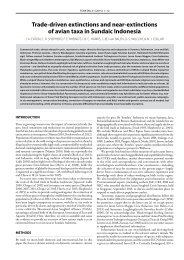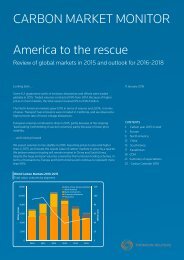Emissions Trading Worldwide
1TbjEHd
1TbjEHd
Create successful ePaper yourself
Turn your PDF publications into a flip-book with our unique Google optimized e-Paper software.
“China’s intention to launch a unified<br />
national carbon market by 2017 was<br />
unequivocally confirmed at the highest<br />
political level.”<br />
5.00<br />
3.75<br />
2.50<br />
million tons 2014 2015<br />
State Council (LAO). The NDRC are endeavoring to put the ETS legislation<br />
into the 2016 work plan of LAO, with the aim of passing a<br />
national ETS regulation in the same year.<br />
The establishment of an offset mechanism is an important<br />
element in the development of an institutional framework for an<br />
ETS. 2015 is the first year that credits generated by China Certified<br />
<strong>Emissions</strong> Reductions (CCER) projects have been surrendered for<br />
compliance in the pilot schemes. The successful use of these credits<br />
indicates that both the offset system and the national registry<br />
are ready for the national market. As of 25 December 2015, there<br />
were 1078 CCER projects in the pipeline, of which 339 projects have<br />
been approved for registration (see Figure 4), and 83 projects with<br />
about 25 million tons of CCERs have been issued.<br />
pilot schemes<br />
Shanghai<br />
Shenzhen<br />
guangdong<br />
beijing<br />
Tianjin<br />
Table 1: Comparison of compliance rates in 2013 and 2014<br />
compliance rate 2013 compliance rate 2014<br />
100% (191/191) 100% (190/190)<br />
99.4% (631/635) 99.7% (634/636)<br />
98.9% (182/184) 100% (184/184)<br />
97.1% (403/415) 100% (543/543)<br />
96.5% (110/114) 99.1% (111/112)<br />
Intense preparations needed throughout 2016<br />
With high-level political commitment confirmed, and the national<br />
ETS legislation under development, it is critical that preparations<br />
for system design and implementation progress through 2016.<br />
In particular, historical data reporting and the preparation of an<br />
allowance allocation plan will need to be advanced. In 2015, the<br />
NDRC held a number of working conferences with provincial<br />
authorities aimed at advancing technical work at the local level.<br />
Then, on 11 January 2016, the NDRC released the landmark Notice<br />
on Key Works in Preparation for the Launch of the National ETS 2 (the<br />
Notice), which paves the way for local level work in preparation<br />
for the launch of the national ETS in 2017. In the Notice, the NDRC<br />
gives provincial authorities a clear mandate to prepare for the<br />
national ETS. It outlines the scope of the national system and provides<br />
important information for local level preparation, including<br />
key steps, a timeline for implementation, clear technical guidance,<br />
and templates for data reporting and verification.<br />
The Notice defines the scope for historical data reporting and<br />
the selection of covered entities. The power sector (coal-fired and<br />
gas-fired power generation, combined heat and power generation,<br />
and grids), petrochemical production (crude oil processing,<br />
ethylene production), chemical production (ammonia, carbide,<br />
and methanol production), building materials (cement clinker and<br />
plate glass production), crude steel production, nonferrous metals<br />
(electrolytic aluminum, copper smelting), pulp and paper production,<br />
and aviation (passenger air transport, air cargo transport<br />
and airports) are the first industries to be included. Within these<br />
sectors, legal entities whose annual energy consumption exceeds<br />
1.25<br />
0.00<br />
Jan. Feb. Mar. Apr. May Jun. Jul. Aug. Sep. Oct. Nov. Dec.<br />
Figure 3: Monthly trading volume comparison in five pilot schemes.<br />
10,000 tons of standard-coal-equivalent in any of the years 2013,<br />
2014, or 2015, are to be identified by provincial authorities and<br />
compiled into a list of potential covered entities.<br />
The provincial authorities are then requested by the NDRC to<br />
collect verified historical data reports from the potential covered<br />
entities, in order to prepare a national allocation plan. To guide<br />
this process, the NDRC has issued reporting guidelines for covered<br />
sectors. 3 The NDRC has also prepared additional reporting templates,<br />
verification guidelines and templates to facilitate historical<br />
data collection. Potential covered entities are requested to report<br />
historical data for the period from 2013–2015, and all historical<br />
data reports are to be subject to third-party verification.<br />
To further facilitate data reporting and verification, the NDRC<br />
has created a national MRV Q&A platform. Stakeholders will be<br />
able to ask technical questions, either via an online system or a<br />
telephone helpdesk, and all official answers will be posted on the<br />
platform website. As data reporting and verification will take place<br />
in parallel across the various provinces, it is important to provide<br />
centralized guidance for using the reporting and verification<br />
guidelines and templates. Such guidance will ensure that rules are<br />
implemented consistently, ensuring, for example that “a ton is a<br />
ton” across all provinces.<br />
Capacity building is also a critical task for 2016, considering the<br />
limited experience of stakeholders, particularly in the non-pilot<br />
regions. Both the NDRC and the provincial authorities will need to<br />
secure the necessary resources to enhance capacity building, and<br />
strengthen policy research and consultation.<br />
Others 10% Methane Recovery and Utilization 13%<br />
Wind Power 36%<br />
Figure 4: Distribution of registered CCER projects by category<br />
Hydro Power 18%<br />
Biomass 9%<br />
Solar Photovoltaic 14%<br />
international carbon action partnership<br />
17




